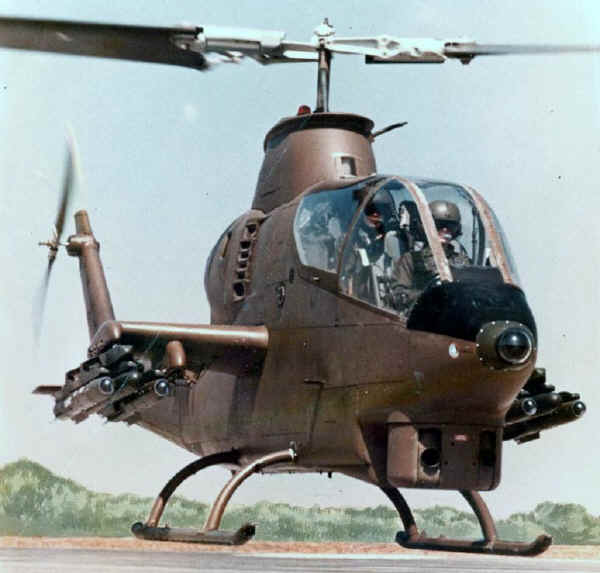| The Lockheed AH-56A
Cheyenne was designed to meet the US Army's requirement for the Advance
Aerial Fire Support System (AAFSS), a program which began in 1964.
Lockheed rolled-out the first prototype on 03 May 1967. While the Army
went forward with its sophisticated AAFSS program to provide an attack
helicopter, Bell proceeded with another company-sponsored prototype,
Model 209, using the Huey dynamics and an airframe similar to the
initial design. Bell Helicopter-Textron began design of the model 209
AH-1 "Huey" Cobra in 1965 as a successor to it's UH-1B/UH-1C
"Huey" in the gun ship role. The result, incorporating the
best features from the UH-1C "Huey", and many parts in common
with the UH-1D, was the World's first attack helicopter. The 209 first
flew in September 1965.

The Army wanted a small agile Advanced
Attack Helicopter (AAH) with a less complicated fire control and
navigation system than the AH-56A Cheyenne. The urgent need for greater
armed helicopter performance in Vietnam and the success of the 209 led
to Army orders for prototypes and production models of the 209 as
interim attack helicopters, pending production of the AAFSS (which,
finally, was never to occur). Carried over from the 209 were the slim
fuselage with tandem cockpits (gunner in front of pilot), the Lycoming
T-53 engine, stub wings with store stations and the under nose turret.
Its retractable skid landing gear was replaced by a fixed gear. The Bell
(model 209) AH-1G Cobra featured the new "540" wide-bladed
rotor, and a slim fuselage, that gave it twice the speed of the UH-1B
Huey. It could could loiter over the target area three times as long,
and had an improved armament system over previous gun ships.
The decision to buy the Cobra, which
was built primarily of Huey parts and thus a quick and relatively cheap
development for Bell, created strong conflict within the Army between
operators and material developers. At this time the material developers
had spent years and huge amounts of money developing the advanced AH-56
Cheyenne attack and reconnaissance helicopter. After several months of
discussion, the Chief of Staff of the Army called the director of Army
Aviation and the Vice Chief of Staff of the Army into his office to
settle the issue. He asked the director of Army Aviation Colonel George
P. Seneff what the soldiers in Vietnam needed. Colonel Seneff told Chief
of Staff General Harold K. Johnson and Vice Chief of Staff General
Creighton Abrams that the soldiers were dying now, not in the future.
They needed the Cobra. Partly based on their suggestion, General Johnson
made the decision to buy the Cobra.
Bell Helicopter won the competition
for an interim fast armed escort helicopter in March 1966, against the
Sikorsky S-61 and the Kaman HH-2C Tomahawk. DOD contracted with Bell
Helicopter, Inc. (BHI) for 1,100 AH-1G aircraft, which logged more than
1 million flight hours in Vietnam.
Based on his belief that Seneff
accurately represented the needs of the soldiers on the ground and had a
strong sense of loyalty and integrity, General Johnson also almost
immediately sent Colonel Seneff to Vietnam as the first commander of the
1st Aviation Brigade. Immediately upon arriving in Vietnam, Seneff
called in all aviation commanders and told them that the Army needed
standardization for aviation, and that it would start right there, in
Vietnam.
The AH-1G Cobra [or Snake] was
first deployed to Vietnam in September 1967. The Cobra's primary mission
was to give fire support to troop carrying Hueys. Its trial-by-fire
introduction to service as the AH-1G in Vietnam immediately provided
ground commanders with air superiority without the wait of calling in
the Air Force. The narrow 38 inch wide airframe presented a much more
difficult target than it's derivative, the 100 inch wide UH-1
"Huey". During the Vietnam War, the AH-1G Cobra was used
extensively in a variety of missions ranging from armed escort and
reconnaissance to fire suppression and aerial rocket artillery. The
Cobra, or "Snake", was often used effectively when paired with
an unarmed OH-6A Cayuse "Loach" or OH-58A Kiowa light
observation helicopter or a UH-1H "Nighthawk".
During the early 1970s, the Army
conducted a series of tests in Ansbach, Germany. The tests were to
determine the suitability of air cavalry elements and the AH-1G Cobra,
in particular, to operate in an antitank role in the European
environment. These tests demonstrated that antiarmor helicopter teams,
properly employed and trained, could achieve high ratios of armored
vehicles destroyed for every missile-firing helicopter lost. Armed scout
and attack helicopters--especially when operating in nap-of-the-earth
and nighttime environments--clearly were shown to have the required
survivability and to be viable and essential elements of conventional
mid- to high-intensity warfare. Thus the way was paved for the
development of the modern attack and scout helicopters and the doctrinal
principles that would take Army aviation into the next century.
text from http://www.globalsecurity.org |